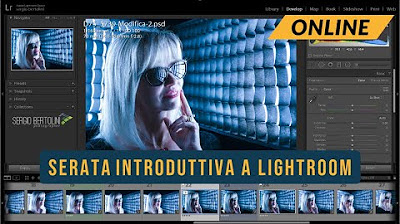5 FREE Lightroom Alternatives | Edit your photos for free today!
Summary
TLDRThe video explores five free alternatives to Adobe Lightroom for photo editing, focusing on their features, strengths, and drawbacks. Darktable, RawTherapee, Pixlr, Polarr, and LightZone are reviewed, with insights into their compatibility, editing tools, and user experience. Darktable and RawTherapee are highlighted for their powerful, in-depth controls, whereas Pixlr and Polarr are simpler but offer effective editing for beginners. The video also discusses issues like lag and compatibility, especially for Mac users, and the pros and cons of each program compared to Adobe's offerings. Viewers are encouraged to experiment with these free tools to find a suitable Lightroom alternative.
Takeaways
- 📸 There are several free alternatives to Adobe Lightroom that offer varying levels of photo editing capabilities.
- 💻 Darktable is an open-source option with a layout similar to Lightroom, but it lacks some features like panorama stitching and can be slower in responsiveness.
- 🔑 Darktable has customizable shortcuts, which might require adjustment for Mac users, as it defaults to Windows-style shortcuts.
- 🌐 Pixlr is an online photo editor resembling Photoshop, with a strong focus on layers and filters, but it doesn’t support RAW files.
- 🚫 Pixlr has a subscription model to remove ads and unlock additional features, but it may not be as comprehensive as Adobe's offerings.
- 📷 RawTherapee is another open-source editor with extensive RAW support and detailed editing tools, though it requires good file organization as it doesn't import images directly.
- 🖼️ Polar is a mobile-friendly editor focusing on filters and local adjustments, with many pro features locked behind a subscription.
- 🚀 LightZone offers advanced editing capabilities but may have compatibility issues, particularly on Mac systems.
- 🆓 All these alternatives are free, offering options for users looking to avoid Adobe's subscription fees.
- 📝 The video encourages users to try out different editors to find the best fit for their needs and provides links in the description for easy access.
Q & A
Why is the author looking for free Lightroom alternatives?
-The author's Adobe subscription is up for renewal, and they are exploring free alternatives to Lightroom to avoid the cost of renewing the subscription.
What is one of the main advantages of free photo editing software, according to the author?
-One main advantage is that you don't need to commit to a purchase or trial period, meaning you can download and use the free software indefinitely without time restrictions.
What are some of the key features of Darktable that make it similar to Lightroom?
-Darktable has a similar layout to Lightroom, with a film strip along the bottom, panels on either side, and modules for editing. It also supports raw files from over 400 different cameras.
What is a disadvantage of using Darktable compared to Lightroom, based on the author's experience?
-The author found Darktable to be laggy when making adjustments, with changes taking a short while to reflect, which is slower than Lightroom.
Why might Mac users find Darktable's shortcuts frustrating?
-Darktable uses Ctrl+Z for undo, even on Mac, whereas most Mac users are accustomed to using Command+Z. This inconsistency can cause confusion for those who are used to Mac's standard shortcuts.
What is a significant feature missing from Darktable that Lightroom offers?
-Darktable does not currently offer the ability to create stitched images, such as panoramas, which is a feature available in Lightroom.
What editing style does Pixlr focus on, and why might it not be suitable for all photographers?
-Pixlr focuses on a Photoshop-style editing workflow with layers and filters, making it ideal for creating thumbnails or composite images but less suitable for photographers who need raw file support, as it only supports JPEG, PNG, and PSD formats.
What makes RawTherapee stand out for raw file processing?
-RawTherapee excels at handling raw files with advanced demosaicing algorithms, pixel shift, multiple frame raw files, and features like hot pixel correction, making it ideal for detailed raw image processing.
What issue did the author face with RawTherapee regarding external hard drives?
-The author had difficulty getting RawTherapee to recognize images stored on an external hard drive, which required them to transfer the images to their computer's internal storage for the program to read them.
Why did the author struggle to get LightZone to work, and what was the suspected cause?
-The author couldn't get LightZone to function properly on their Mac, likely due to compatibility issues or Mac's stringent security systems, as well as potentially limited developer support for the Mac version.
Outlines

Esta sección está disponible solo para usuarios con suscripción. Por favor, mejora tu plan para acceder a esta parte.
Mejorar ahoraMindmap

Esta sección está disponible solo para usuarios con suscripción. Por favor, mejora tu plan para acceder a esta parte.
Mejorar ahoraKeywords

Esta sección está disponible solo para usuarios con suscripción. Por favor, mejora tu plan para acceder a esta parte.
Mejorar ahoraHighlights

Esta sección está disponible solo para usuarios con suscripción. Por favor, mejora tu plan para acceder a esta parte.
Mejorar ahoraTranscripts

Esta sección está disponible solo para usuarios con suscripción. Por favor, mejora tu plan para acceder a esta parte.
Mejorar ahoraVer Más Videos Relacionados

I Replaced ALL my ADOBE APPS with these [free or cheaper] Alternatives!

8 Lightroom Alternatives That Will Save You Money!

I Edited The Same Video on Every FREE Software

Serata Introduttiva a Lightroom 1a parte

Adobe Photoshop vs Lightroom Classic | What One Is Right For You?

The MOST powerful smartphone! A17 Pro vs 8 Gen 3 vs Dimensity 9300 vs Exynos 2400 vs Tensor!
5.0 / 5 (0 votes)
